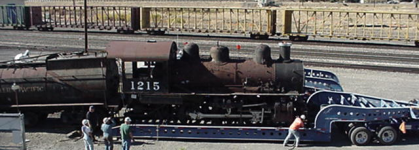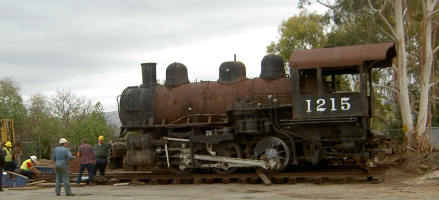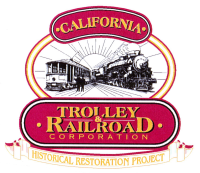SP1215: Do you know the way to San Jose?
By Ken Middlebrook

On Tuesday, October 16, CTRC's steam locomotive #1215 was unloaded at the San Jose Historical Museum after a two day 300 mile interstate travel from Portola, California. This successful move was the culmination of support made by various individuals both within and outside CTRC.
1215's journey began in late January after the completion of the asbestos abatement in Portola (as reported in an earlier CLEARBOARD). A new home would be needed closer to San Jose. Originally, the new home was hoped to be the location of our railroad museum; however despite the progress made, those plans have not matured. As a result, several alternatives were explored with a primary consideration of accessibility for CTRC volunteers. Through the efforts of CTRC's Bob Schneider and History San Jose's CEO Alida Bray, a suitable location was identified at the historical museum's employee parking lot behind our trolley barn.
With no rail access, the locomotive's new location dictated the method for the actual move: by truck … a very LARGE truck. 1215's weight of 75 tons and her tender's weight of 25 tons would require specialized equipment. In early spring, the Sierra Railroad moved by truck a similarly sized locomotive from McCloud to Oakdale. Sierra's chief master mechanic, Larry Ingold, was contacted. Larry was a founding member of our effort to restore 2479. To minimize the need for lifting by crane and highway bridge height restrictions, a recommendation was made toward Taylor Heaving Hauling located near Roseville.
Taylor has extensive railroad equipment experience utilizing massive trailers that could handle the weight and enable the locomotive and tender to roll on and off. To accommodate various schedules, a mid October timeframe was selected and the focus was made toward preparation of the historical museum site. Gene Martin and Bob led the effort in cleaning up this unloading site which was immediately behind the trolley barn. To minimize the space, the locomotive and tender would be stored perpendicular to one another.
Jack Young, John Ezovski and Bob Paddleford coordinated the moving of previously constructed panel tracks from the fairgrounds to the history museum. In addition to contacting with Joe Bauer and Peninsula Crane and Rigging, the team had to ensure that working forklifts were available at both sites. On Friday, October 5th, two panels were moved by PCR and placed in the perpendicular arrangement. Almost immediately, questions arose on "will this work?"
A call was made to Rich Taylor who, without hesitation, responded, "end to end, the rig is 120ft long and needs straight access to unload." Furthermore, the trailer would unload from the front thereby requiring Taylor to back the rig into the parking lot from Senter Road. Our perpendicular location would not accommodate Taylor's unloading requirements and we were within a week of our deadline. Decisions would have to be made soon or the move would have to be postponed. Furthermore, winter weather had arrived early in the high Sierras where not only the 1215 was located but where she was scheduled to cross the mountain range.
Bob and Gene went back to their tape measures in the parking lot and selected a new location that would allow the locomotive and tender to be stored in a parallel arrangement. However, this new location would require the movement of 40 cubic yards of dirt. Ironically, this dirt pile was the result of the CTRC's trolley barn inspection pit construction several years ago. Additionally, it was learned that events at the history museum needed full access in the parking lot beginning Thursday, October 18. Time was now ticking…
Calls were made to several parties about moving the dirt. It could be done but unlikely in the time frame (less than four days) needed. A decision was made to unload and temporarily store 1215 in front of the dirt pile. This action, however, would require additional panel tracks from the fairgrounds. On Friday, October 12, the final go ahead was made. Due to incoming Sierra storms, Taylor now planned to load on Sunday, October 14, a day earlier than planned. A CTRC crew would be in Portola on Sunday to ready the locomotive for the move. This may be interesting. Sunday, October 14 - Loading in Portola
Nearly 18 months ago, a CTRC crew removed many items off 1215 in preparation of the abatement and an eventual move to San Jose; however, some items, previously removed by the Feather River Railroad Society, remained safely stored in a boxcar on site. These items would have to be retrieved by CTRC. More importantly, the locomotive and tender would have to be separated to enable transport by Taylor. The separation would require dropping the large drawbar pins.
Just before noon, Hugh Crawford, Terry Johnson, Denis Murchison, Larry Murchison and I arrived in Portola. Soon after our arrival, Taylor's crew arrived. A quick discussion ensued to confirm loading arrangements to place the locomotive facing north, toward the electric tower at the History Museum. This would require the locomotive to travel backwards to San Jose.
John Walker, the FRRS' museum manager reported that a locomotive engineer would be available latter to assist with the loading. While Taylor begun to position their equipment, the CTRC crew focused on dropping the draw bar pins, which, fortunately, took a span of five minutes! Ironically, the main pin was then placed back into the draw bar to enable moving the locomotive and tender by rail.
Appropriately, the available FRRS locomotive engineer was Norman Holmes. Norm is a San Jose native and author of several railroad books including, Prune County Railroading: Steel Rails to San Jose. Upon his arrival, Norm provided several photographs of 1215 and a set of Southern Pacific drawings of a similar locomotive class. Additionally, Norm remarked, "Be sure to take the windows for the '15." Windows? He then relayed that after the 1215 was placed on display in 1958, a city employee removed the windows and frames for safekeeping. After FRRS moved the 1215 to Portola in 1995, a Hanford city employee contacted Norm and asked if there was an interest in the windows. Needless to say, the same windows now belong to CTRC!
Complementing the blue skies and mild temperature, the actual loading was uneventful. With Norm operating Sierra Pacific #1100, an EMD diesel locomotive pushing two idler cars, a flat and short hopper car (a wise choice), the locomotive was loaded first at the end of track. Once the locomotive was safely chained down to the trailer, Hugh Crawford and I removed the drawbar pin. Norm pulled the tender back and waited as the Taylor crew repositioned the trailers. During this lull, the CTRC crew retrieved most of the stored 1215 parts at Portola.

The trailer to be used for the tender was positioned directly over the tracks resulting in a steep up-ramp to negotiate. As the tender was pushed up the ramp, the coupler knuckles between the tender and hopper car began to slip vertically leaving a ½" point of contact. FRRS yardmaster Steve Habeck's selection of the particular short hopper car for this situation became apparent as just when we thought the loading would be lost, the hopper's leading wheel set began to climb the ramp and raising its couple knuckle in the process. Whew!
With both loads tied down, Taylor's crew left Portola a little past 6:00 pm. Monday, October 15 - In Transit
Due to the extreme weight, the 300+ mile routing to San Jose involved going east into Nevada and south on highway 395 to Minden before turning west on highway 88 to climb Carson Pass over the Sierras. Sunday night, the caravan stopped on highway 395 just outside of Reno. At the steepest portion of Carson Pass, Taylor used a "push-rod" method which involved the truck carrying the trailer pushing the heavier rig with the locomotive. Sadly, no pictures were taken of this 200 foot long configuration. Despite experiencing two flat tires en route, Taylor was able to overnight in Livermore as planned.
Back in San Jose, a flurry of communication occurred to ensure that the unloading would go smoothly. Extra Panel Track. Tools. Cribbing. Joint Bars, Forklifts, People, Weather forecast. Etc. There's a lot to consider when a 75 ton package is going to be delivered to your door step! Tuesday, October 16 - Unloading in San Jose
The morning began with a small CTRC crew meeting at the fairgrounds to load material for use at the history museum. PCR provided a truck and trailer to move three extra sets of panel track. By 10:30 am, Taylor's pilot truck arrived at the history museum to review the unloading plan. The tender and locomotive would be unloaded in reverse order of the loading with the tender located on the far track. Soon thereafter, the locomotive and tender arrived on Senter Road.
To position the locomotive trailer correctly, Taylor had to back the 120 ft long rig backwards along Phelen Avenue and into the parking lot. The rig had a separate motor and hydraulic controls on the back set of wheels which enabled steering. When the trailer bottomed going into the lot, the same hydraulic were used to raise the trailer and load. This process was impressive. After positioning the trailer with the tender, a panel track was moved into place and ramps connected. In Portola, we had a luxury of a 125 ton locomotive for assistance. At the historical museum, Taylor's trucks were utilized, one for braking the other for pulling. The 25 ton tender was unloaded smoothly. Next up was the 75 ton locomotive.
Similar to the tender, a panel track was located after the locomotive trailer was in position. Use of Taylor's two trucks would be repeated as done with the tender; however, the panel track was at a slight upgrade. After the locomotive was eased down the trailer, the center driver had difficulty going "up" the panel track due to a ½ vertical difference with the connecting ramp. The placement of the various track shims was changed and a forklift utilized for some extra "push". Nothing. Since braking requirements were no longer needed going down the trailer, Taylor's trucks were repositioned in tandem to pull up the panel track. In this arrangement, the locomotive was quickly placed onto the panel track a little after 3:00 pm.
Ito ensure the locomotive and tender would not move unexpectedly, CTRC chained the equipment to their respective panel track. As a secondary measure, CTRC's resident welder John Blaine, installed wheel chocks on the rail. With the locomotive secured, Taylor's crew gone, and the area cleaned of tools and equipment, it was time to go home. What's Next?
In the short term, the 40 cubic yards of dirt, now immediately behind the locomotive and tender, will have to be moved offsite allowing another length of panel track to be placed. After this prep work is completed, the equipment will be relocated backwards thereby clearing additional space in the parking lot. Soon thereafter, the CTRC crew will create a cosmetic restoration plan and install some interpretive signage for visitors.
The majority of 1215's missing components, such as the headlight, whistle, bell, gauges, etc are in storage and will be returned as time, and security, permits. Eventually 1215 will be relocated to a permanent location after CTRC's Railroad Museum development plans have matured.
Much appreciation goes toward Taylor Heavy Hauling, Peninsula Crane and Rigging, Feather River Railroad Society, and several CTRC volunteers for a safe and successful move of 1215. Over the last few days, CTRC volunteers included: Jack Young, Bill Jump, John Ezovski, Tom Anderson, Bob Paddleford, Denis Murchison, LarryMurchison, John Blaine, Bob Schneider, Gene Martin, Ken Middlebrook, Hugh Crawford and Terry Johnson. It was a team effort!
Lastly, a large "Thank You" is extended toward Alida Bray and History San Jose for providing the needed storage space.
